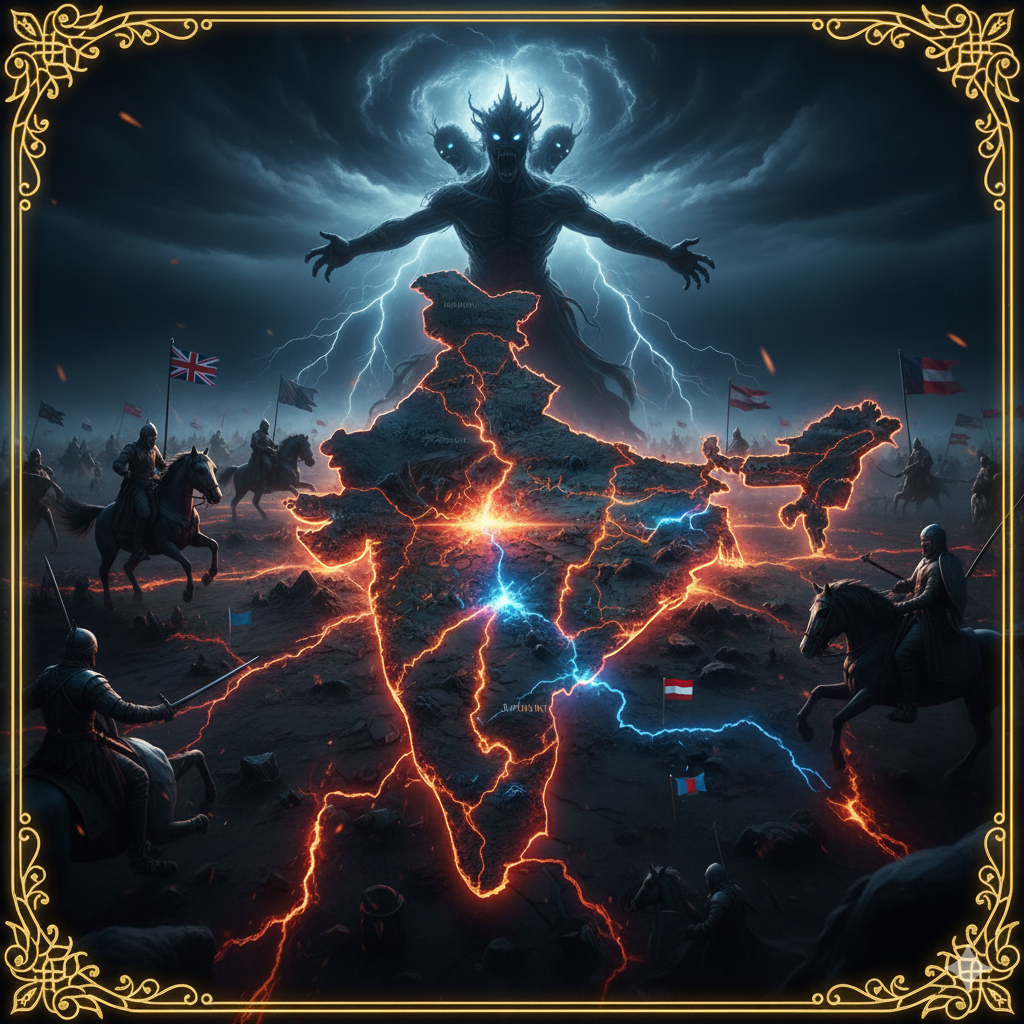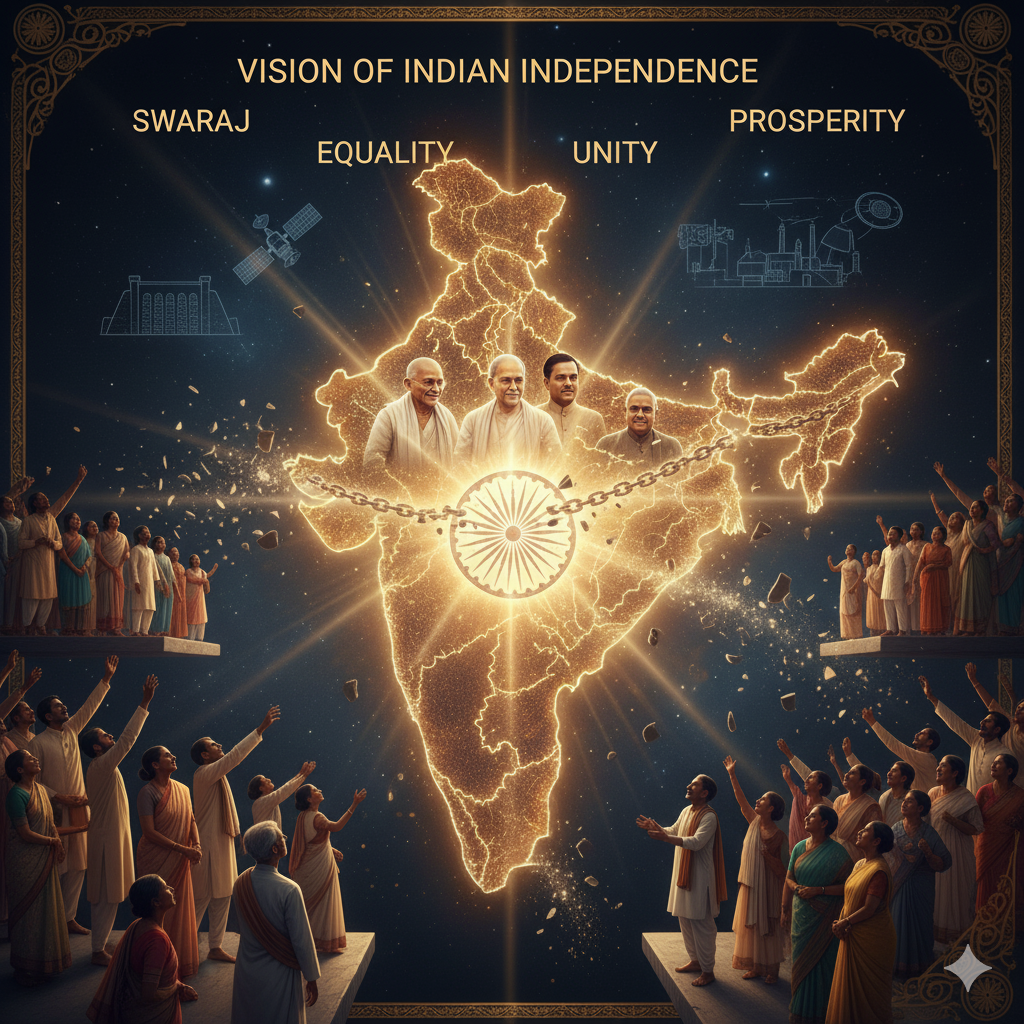Introduction
The mid-eighteenth century represents one of the most transformative and tumultuous phases in Indian history. This period witnessed the decline of the Mughal Empire, the rise of regional powers, and the gradual establishment of British colonial authority. The political landscape of India during this time was marked by fragmentation, instability, and the erosion of centralized authority. The once-mighty Mughal Empire, which had provided administrative unity and political coherence, had weakened to a point where multiple regional forces competed for dominance.
The resulting fragmented polity was characterized by power struggles among regional kingdoms, economic decline, foreign invasions, and the emergence of new political actors. This disunity not only weakened the subcontinent’s internal cohesion but also paved the way for the British East India Company to extend its control, transforming India’s political destiny forever.
This essay explores the political, economic, social, and military conditions of mid-eighteenth-century India and examines how fragmentation and lack of unity led to the fall of indigenous powers and the rise of colonial rule.
1. The Decline of the Mughal Empire: The Beginning of Fragmentation
(a) Weak Successors after Aurangzeb
The death of Emperor Aurangzeb (1707) marked a turning point in Indian history. His successors — Bahadur Shah I, Jahandar Shah, Farrukhsiyar, and Muhammad Shah — lacked the competence, vision, and authority to maintain the vast empire. Court intrigues, factionalism among nobles, and regional rebellions weakened the central administration.
The Mughal emperor had become a symbolic head, with real power shifting to regional satraps and provincial governors (subedars).
(b) Rise of Powerful Nobles and Provincial Governors
The Mughal nobility, which once served as the backbone of imperial administration, became divided into factions based on ethnic and personal loyalties — Turani, Irani, Hindustani, and Afghan. Many governors, such as the Nizam of Hyderabad, the Nawab of Bengal, and the Nawab of Awadh, began to act independently, maintaining only a nominal allegiance to the emperor.
This process of provincial autonomy accelerated the disintegration of the empire and led to the emergence of multiple, competing centers of power.
(c) Administrative and Economic Decay
The Mughal administrative system, once efficient under Akbar and Shah Jahan, had decayed. The Jagirdari system became corrupt and exploitative. Revenue farming and excessive taxation led to the impoverishment of peasants and decline in agricultural productivity. This economic instability further weakened the state’s capacity to maintain order.
2. The Rise of Regional Powers
As the Mughal center collapsed, regional powers rose to fill the vacuum. These states represented the fragmented polity of mid-eighteenth-century India, each pursuing its own ambitions.
(a) The Nizam of Hyderabad
Founded by Nizam-ul-Mulk Asaf Jah in 1724, Hyderabad emerged as one of the most powerful successor states. Though the Nizam maintained nominal loyalty to the Mughals, he ruled independently. Hyderabad became a center of Deccan politics but was plagued by internal strife, Maratha raids, and British and French interference.
(b) The Nawabs of Bengal
Bengal, under Murshid Quli Khan, Alivardi Khan, and later Siraj-ud-Daula, enjoyed prosperity due to its fertile land and active trade. However, internal corruption, administrative inefficiency, and conflicts with the British East India Company culminated in the Battle of Plassey (1757), which marked the beginning of British political dominance.
(c) The Nawabs of Awadh
Awadh, established under Saadat Khan Burhan-ul-Mulk, developed as a semi-independent state with Lucknow as its capital. It became a cultural and administrative hub but faced challenges from both Delhi and regional rivals. Eventually, British interference through treaties and alliances weakened its autonomy.
(d) The Marathas
The Marathas, under the leadership of the Peshwas, rose to prominence after the decline of Mughal authority. They expanded rapidly under Balaji Vishwanath and Baji Rao I, controlling much of western and central India. However, the Third Battle of Panipat (1761) against Ahmad Shah Abdali dealt a massive blow to their power. The Maratha Confederacy, though strong, remained a loose coalition of regional chieftains, often lacking unity in military and political strategy.
(e) The Sikhs
In Punjab, the Sikh Misls emerged as independent warrior bands following the decline of Mughal control. The Sikh polity was initially decentralized but later unified under Maharaja Ranjit Singh in the early 19th century. In the 18th century, however, Punjab was a region of military instability and Afghan invasions.
(f) Mysore and the Southern States
In South India, new powers like Mysore under Hyder Ali and Tipu Sultan, and Travancore under Marthanda Varma, emerged as strong regional players. The Carnatic region saw continuous warfare among the British, French, and local rulers, which further complicated the political scene.
These multiple centers of power reflected a highly fragmented political order, each vying for supremacy in the absence of a strong central authority.
3. Foreign Invasions and Their Impact
(a) Nadir Shah’s Invasion (1739)
The invasion of Nadir Shah of Persia exposed the weakness of the Mughal Empire. His sack of Delhi and the looting of immense wealth—including the Peacock Throne and Koh-i-Noor—shattered the empire’s prestige. It revealed India’s vulnerability to foreign aggression and accelerated the disintegration of Mughal authority.
(b) Ahmad Shah Abdali’s Raids
Ahmad Shah Abdali, the Afghan ruler, invaded India multiple times between 1748 and 1767. His repeated incursions devastated North India, depopulated fertile regions, and culminated in the Third Battle of Panipat (1761). The defeat of the Marathas in this battle created a power vacuum in northern India that the British would later exploit.
4. The Role of the European Trading Companies
While indigenous powers struggled among themselves, the European trading companies, particularly the British East India Company and the French East India Company, became decisive actors in India’s political landscape.
(a) British and French Rivalry
The British and French competed for commercial and political supremacy in India. The Carnatic Wars (1746–1763) were the first signs of European militarization of Indian politics. Both sides supported rival Indian claimants to thrones and manipulated internal rivalries for their benefit.
(b) British Ascendancy after Plassey and Buxar
The Battle of Plassey (1757) and the Battle of Buxar (1764) consolidated British power in Bengal. The British acquired Diwani rights (revenue collection) from the Mughal emperor Shah Alam II, marking the start of colonial rule. The British success owed much to the disunity and rivalry among Indian powers, which prevented a collective resistance.
5. Economic Decline and Political Disunity
The mid-eighteenth century saw a severe economic downturn due to political instability, excessive taxation, and warfare. Trade routes were disrupted, agriculture suffered, and artisans faced unemployment. The economic decline further fragmented the polity:
- Collapse of Long-distance Trade: Continuous warfare and loss of state protection affected India’s traditional trade networks.
- Rise of Private Armies: Local rulers and zamindars maintained their own militias, weakening central authority.
- Corruption and Revenue Mismanagement: The Mughal revenue system became exploitative, driving peasants into misery and rebellion.
- Decline of Urban Centers: Cities like Delhi, once centers of art and commerce, faced depopulation and destruction.
This economic distress deepened political disunity, as regional powers prioritized short-term survival over collective stability.
6. The Fragmented Polity: Nature and Features
The fragmented polity of mid-eighteenth-century India can be described through the following characteristics:
- Absence of Central Authority: The Mughal emperor’s power was merely symbolic; real control rested with regional rulers.
- Rise of Independent States: Bengal, Awadh, Hyderabad, and others functioned autonomously.
- Intense Regional Rivalries: Frequent wars between Marathas, Nizam, and other powers drained resources.
- Foreign Interference: European powers exploited Indian divisions to advance their interests.
- Decline of National Consciousness: Political loyalty remained regional or dynastic rather than national.
- Economic and Administrative Chaos: Corruption, revenue failures, and local rebellions weakened stability.
7. The British Exploitation of Fragmentation
The British East India Company skillfully used India’s political disunity to expand its influence.
- Diplomacy and Divide-and-Rule: The British aligned with one Indian power against another, promising military support and then asserting dominance over both.
- Superior Organization and Finance: The British had disciplined armies, modern weapons, and efficient administrative systems.
- Use of Treaties and Subsidiary Alliances: Later, under Lord Wellesley, these mechanisms legally bound Indian states to British supremacy.
- Economic Exploitation: Control of Bengal’s resources gave the British immense financial leverage to fund further conquests.
Thus, the fragmented polity of mid-eighteenth-century India became a stepping stone for the establishment of the British Empire in India.
8. Social and Cultural Implications of Political Fragmentation
Political disunity also had significant social and cultural consequences:
- Decline of Mughal Cultural Patronage: The arts, literature, and architecture suffered due to political instability.
- Regionalization of Culture: New centers like Lucknow, Hyderabad, and Pune emerged, fostering regional languages and art forms.
- Erosion of Public Morality: Widespread corruption and moral decline were reported in both administration and society.
- Rise of Local Identities: The collapse of imperial unity encouraged regional consciousness but weakened pan-Indian cohesion.
Despite the chaos, this cultural diversification sowed the seeds of India’s later social transformation.
9. The Spectre of Fragmentation: Causes and Consequences
(a) Causes
- Decline of Mughal central authority
- Rise of provincial ambitions
- Foreign invasions and economic exhaustion
- Military inefficiency and technological backwardness
- Absence of national unity or collective vision
(b) Consequences
- Weakness against foreign powers
- Rise of colonialism
- Economic decline and social disorder
- Breakdown of law and order
- Loss of sovereignty and national identity
This fragmentation represented not merely political disunity but also a crisis of civilization, where moral, cultural, and administrative decline went hand in hand.
10. Transition to British Colonial Rule
The political instability of mid-eighteenth-century India set the stage for British imperial expansion. Between 1757 and 1818, the British systematically eliminated rival Indian powers through war, diplomacy, and alliances. The fragmented polity provided the ideal environment for colonial conquest.
- Bengal fell after Plassey (1757).
- Mysore was subdued after the Anglo-Mysore Wars.
- Marathas were defeated in the Anglo-Maratha Wars.
- Punjab and Awadh followed by mid-19th century.
Thus, the fragmented polity of the eighteenth century evolved into the colonial state of the nineteenth century, where British power stood unchallenged.
11. Historical Interpretations
Historians have offered different interpretations of this fragmentation:
- Colonial Historians argued that India lacked political unity and was naturally prone to foreign domination.
- Nationalist Historians countered that India had a shared civilization and moral unity but was weakened by imperial exploitation.
- Marxist Historians emphasize class and economic factors—decline of feudal structures and emergence of colonial capitalism.
Modern scholarship views this period as a transition, not merely a decline—where old structures disintegrated, giving rise to new social and political forms.
12. Conclusion
The mid-eighteenth century was a watershed moment in Indian history — a period of transition from Mughal imperial grandeur to colonial subjugation. The fragmentation of political authority, coupled with economic and social decay, created an environment ripe for foreign intervention.
India’s fragmented polity was not simply a story of decline but of transformation — the collapse of a centralized empire and the emergence of diverse regional powers that expressed India’s complex plurality. Yet, the lack of unity and coordination among these powers allowed the British to impose their rule, leading to nearly two centuries of colonial domination.
In conclusion, the spectre of a fragmented polity in mid-eighteenth-century India stands as both a warning and a lesson — that political disunity and moral decline can open the door to subjugation, while strength lies in cohesion, cooperation, and collective vision.




